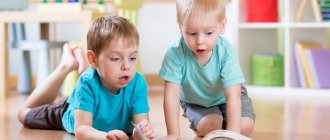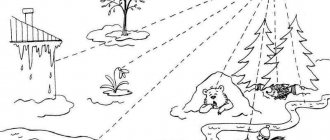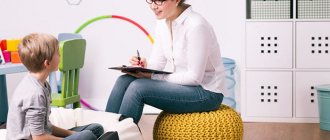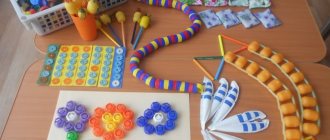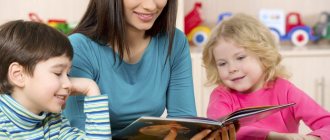During the fourth year of life, children experience one of the most significant leaps in their development. Human speech begins to be of unprecedented interest to them; they actively try to talk, repeating all the sounds that are available to them. It is at this time that parents and teachers should listen carefully, noting whether the characteristics of the child’s speech fit into the norm, and whether a 3-4 year old child requires speech therapy classes.
What should the speech of a 3-4 year old child be like?
Scientists have calculated that at this age a child’s vocabulary ranges on average from 1,500 to 2,000 words. Such calculations are difficult to make at home, but there are several simpler indicators that can easily be used to determine how well a child’s speech development falls within the normal range.
There is no cause for concern if the child:
- actively tries to reproduce all the sounds and words he hears, especially those that are new to him;
- engages in word creation;
- makes simple sentences naming actions (the ball flies, the fish swims, the dog barks);
- tries to compose complex sentences and stories, but at the same time does not speak very clearly and makes many speech errors;
- can talk about himself in the third person;
- enjoys repeating many words after adults, quoting phrases from cartoons;
- does not pronounce all sounds; problems especially often arise with [r], [l], [s] and [w];
- rearranges letters and syllables in words;
- At the same time, he himself understands complex sentences, listens carefully to fairy tales, knows his favorites by heart;
- knows and knows how to say his first and last name, the names of relatives, friends, and the city in which he lives.
The listed signs apply to both boys and girls, although experts say that girls are ahead of boys in speech development by an average of 4-5 months. There are silent children who do not speak in front of strangers, but this does not always mean a deviation from the norm: a sensitive parent usually knows what his baby is really capable of.
At this time, it is important to talk to the child as much as possible, while making sure that your own speech is correct, not to lisp, and to read books to the baby with expression.
Educational "guest" games with several objects
Game "Hide and Seek". The goal is to understand and actively use in speech the prepositions of place “on”, “in”, “under”, “above”, “at/about”. Place children's furniture on the table. “Here we have a room where the girl Lisa lives. Name all the objects in Lisa's room. What word can be used to name all these objects? - Furniture. – Her friends came to visit Lisa - frogs, ducklings, bear cubs. They started playing hide and seek. The little frogs jumped onto the table. The cubs crawled under the bed. The ducklings hid behind the chair. Lisa went to look for animals. Not on the sofa, not under the chair. Who will help Lisa find her little friends? Where are the cubs? Where are the ducklings? The game can be repeated several times. Animal toys may change.
Game “Requests and Instructions”. The goal is to develop skills in constructing the imperative mood. Cat and Bunny are visiting Lisa. If you want the Bunny to do something, ask him about it. “Bunny, jump!”, “Cat, dance!”, “Cat, lie down on the sofa!”, “Bunny, hide!” Encourage your baby to use prefixes to form verbs that denote different actions: jump - jump - jump - jump over, move away - leave - come in - come.
Classes should be daily. Start with 15 minutes and gradually work your way up to a normal school lesson of 40 minutes. Make sure your child understands what is being said and does not automatically repeat what he hears. It would be great if the child would practice such games not only at home, but also with his peers. The task of teaching a 3-year-old child to speak well is quite feasible if you do not retreat, do not give in to difficulties and believe in what you are doing (we recommend reading: how to teach a child to read syllables correctly and smoothly?).
How to recognize disorders and when to contact a speech therapist?
The list presented above is general in nature, but if at least three points from it are not characteristic of a child’s speech behavior, this is a reason to think about it.
Here are some signs that may indicate a delay in your child's speech development:
- the pace of his speech is uneven - he sometimes speaks too quickly, sometimes he drawls out his words;
- speaks unintelligibly, only his mother understands him;
- if he speaks in phrases, then not his own, but only those he heard from adults or on TV;
- he himself has difficulty understanding what adults tell him;
- mouth constantly open, like a limp mouth;
- increased salivation not associated with teething.
If one or more signs from this list are present, it is advisable to diagnose the child’s speech development. Perhaps there really is a pathological disorder that requires special treatment, or perhaps the baby just needs speech therapy exercises. But before contacting a speech therapist, you need to show the child to a neurologist, psychiatrist and speech pathologist: they will help determine whether the delay in speech development is associated with disorders of the central nervous system or the problem is only in the pronunciation of sounds. You may also need the help of an audiologist - a specialist who identifies hearing defects. If doctors have not found any physiological reasons for the development of mental retardation, then the child will benefit from sessions with a speech therapist.
Possible speech defects
There are situations when children, without any problems, are simply too lazy to say words out loud, confident that they will understand them anyway
Parents should pay special attention to the child if he speaks little, confuses syllables and words, does not understand the meaning of what was said - most often this is due to various speech defects that will have to be corrected in speech therapy classes
There are several types of speech impairment possible:
- stuttering;
- dyslalia - children with normal hearing and speech apparatus confuse the consonant phonemes and , and .
- nasality - pronouncing words “in the nose”, which makes understanding the child very problematic;
- the child does not understand the parents’ speech and does not speak himself;
- pronounces sounds incorrectly – difficulties with articulation.
In case of any of them, you should start speech therapy classes - with a professional defectologist and at home, otherwise the child will be left with delayed speech development and may not be accepted into a comprehensive school, or may be asked to attend a specialized institution. But the situation can be corrected through speech therapy.
Types and features of speech therapy classes
Speech therapy sessions can be either individual or group. On the one hand, one-on-one sessions have proven to be more effective, when all the specialist’s attention is directed to a specific child. On the other hand, children feel more comfortable in a group. Most often, a positive result is achieved by alternating these two types of activities: in group, or frontal, classes, children consolidate the skills acquired in individual ones.
Individual sessions
The most important thing for a speech therapist here is to find an approach to the child, to be able to captivate him, to “stir up” him. The baby should feel at ease, play, stick out his tongue in front of the mirror, and repeat after the specialist everything he asks. Therefore, the mood for the lesson is appropriate: it’s all just a game. To learn to pronounce difficult sounds, a child does not even need to know why he came here. For each such sound, the speech therapist has a selection of special game exercises, by performing which the little student imperceptibly improves his speech skills. Breathing exercises, songs, tongue twisters, tongue exercises - all these are effective tools in a specialist’s arsenal.
Group (frontal) classes
If individual speech therapist sessions with children are most often aimed at correcting individual sounds, then frontal sessions involve working with a wider range of deviations in speech development. These can be defects in sound pronunciation, hearing impairment, grammatical problems, and stuttering. Groups are selected small, ideally 7 people; children should be approximately the same age and have similar speech impairments. The lesson is always given some interesting topic, which provides many opportunities to expand children's vocabulary and practice oral speech. For example, in winter, the “New Year” theme is relevant: the room is decorated accordingly, creating a festive, upbeat mood in children, which contributes to the effectiveness of exercises.
As in individual lessons, here a lot depends on the personality of the specialist, on his ability to create the right environment and make children want to express themselves. For children 3-4 years old, for whom the process of socialization is just beginning, it is not easy to create such conditions. Many of them are shy and withdrawn precisely because of their speech impairments. For group speech therapy classes to bear fruit, children must feel confident and free during them.
How specialists work: exercises, games, manuals
One of the most obvious reasons for the incorrect pronunciation of sounds by young children is the imperfection of their speech apparatus. Speech therapy gymnastics helps solve this problem.
There are many fun exercises that children enjoy doing in front of the mirror, repeating after the speech therapist.
- “Window” is the simplest exercise in which the baby must first open his mouth as wide as possible (“it’s hot, open the window!”), and then close it (“it’s cold!”).
- “Brushing your teeth” - the child needs to smile and in this state open his mouth slightly, then run his tongue over the upper and lower teeth, as if with a toothbrush.
- “Cup” - open your mouth again in a smile, stick your tongue out further and give it the shape of a bowl, raising the tip and edges.
- “Fipe” - diligently stretch out your lips, as if with the intention of whistling, while clenching your teeth.
- “Painting the ceiling” - smile, open your mouth slightly and move the tip of your tongue across the sky, as if painting it with a brush.
Children like this kind of gymnastics for the tongue, but it quickly tires them. At the next stage of the lesson, you can move directly to oral speech. Various descriptive games will help with this. For example, the teacher takes out an object or toy from a bag or box and asks the child to name it. Then he asks about the properties and characteristics of the object, pushing the child to describe it (the ball is round, green, small, bouncy). If successful, you can complicate the game: ask the child to put his hand into a bag with a toy and try to tell what it feels like.
The teaching aids include pipes and turntables for breathing exercises, finger toys and exercise machines, sets with tweezers for grasping small parts, tactile bags and boards - there is a very wide choice for professional speech therapists. You can purchase such things for home use, or you can make do with improvised means.
How to work with your child at home?
From parents, first of all, maximum attention is required to the baby, to his interests and discoveries, fears and sorrows. We need to create conditions for him to communicate with the world, take him on walks, show him new places, introduce him to people of different ages. All this broadens the mind and develops the brain, and also strengthens the attachment between children and parents.
The quality of speech is directly influenced by the development of fine motor skills, so any activities with small objects, construction toys, sand, and cereals will be of great benefit in this regard.
You can try special exercises at home. For example, the pronunciation of hissing and whistling sounds is relatively easy to practice on your own, without the intervention of a specialist. As for the sounds [r] and [l], they are considered more difficult to correct, although you can try to “set” them too.
Every parent can reproduce speech therapy gymnastics at home - it will be much more fun and easier for the baby to repeat after his mother than after an unfamiliar aunt. It will take very little time, but will bring great benefits and give pleasant emotions to the participants. For classes, you will need a mirror - preferably a large one, so that the child can freely see both his reflection and the reflection of his mother, performing the exercises “Pipe”, “Cup” and others.
After gymnastics, you can play games with answers to questions, or you can practice pronouncing words containing problematic sounds. If you write these words on cards, it will be more convenient to study. Tongue twisters that are chosen so that the necessary sounds are often repeated in them also work well. It is important to remember that pressure should not be put on the child. Games and activities should not bring him anything but joy and pleasure, otherwise the effect may be exactly the opposite.
Development of general imitation
General imitation is the copying of movements, actions, and facial expressions.
The child reproduces the movements he sees and successfully remembers them when repeated many times.
The mechanism of imitation works on a subconscious level in everyday life, and educators and speech therapists use it consciously when conducting classes with children.
It is important that the child is in the correct speech environment, i.e.
It is better to limit communication with people who have speech impediments. Watch your behavior - words should not contradict actions.
The development of general imitation begins with the repetition of elementary movements, then perform several actions simultaneously. The next stage is the implementation of a whole chain of actions that are logically connected and, as a rule, socially significant (for example, feeding a doll and putting it to bed).
When working with children, follow some rules: your sentences should be clear, simple and not too long; the speech of an adult is emotionally bright, calm, not loud.
General imitation games can be played with one child or with several (usually 3-5 children).
But! Keep in mind that when playing in a group, children imitate not only the adult, but also each other.
Games with general imitation
- Let's do exercises. The point of the game is to follow the adult’s commands (hands up, arms to the sides, jumping, clapping). To maintain interest and attention, invite the children to choose a leader from among themselves.
- Birds. Children play birds. An adult comments on every movement: “We fly like birds! Let's flap our wings up and down! Now the birds are pecking at the grains!” Gradually the pace of the game increases.
- Palms. A series of movements with the palms is performed:
“Palms up (put your palms on the table with the outer side down)!
Palms down (turn your palms over)!
And now put them on their sides (put our palms on their edges)!
And we clenched our fists (we clasp our palms into fists)!”
At first the movements are performed slowly, then faster and without the participation of an adult.
